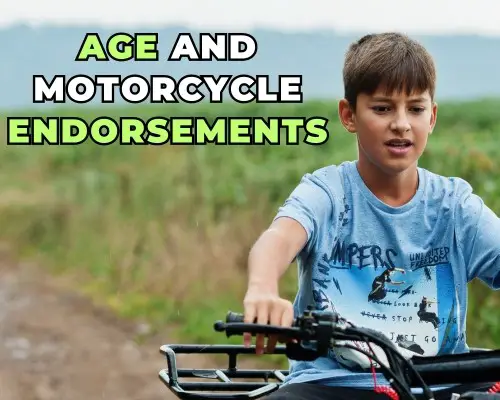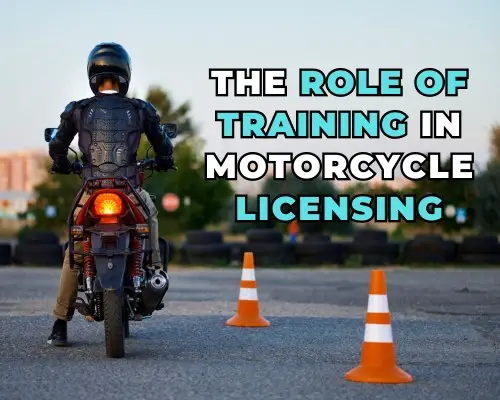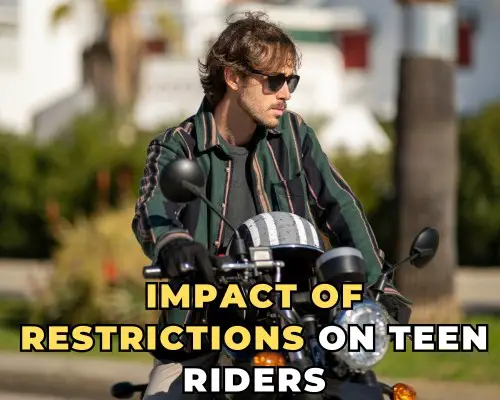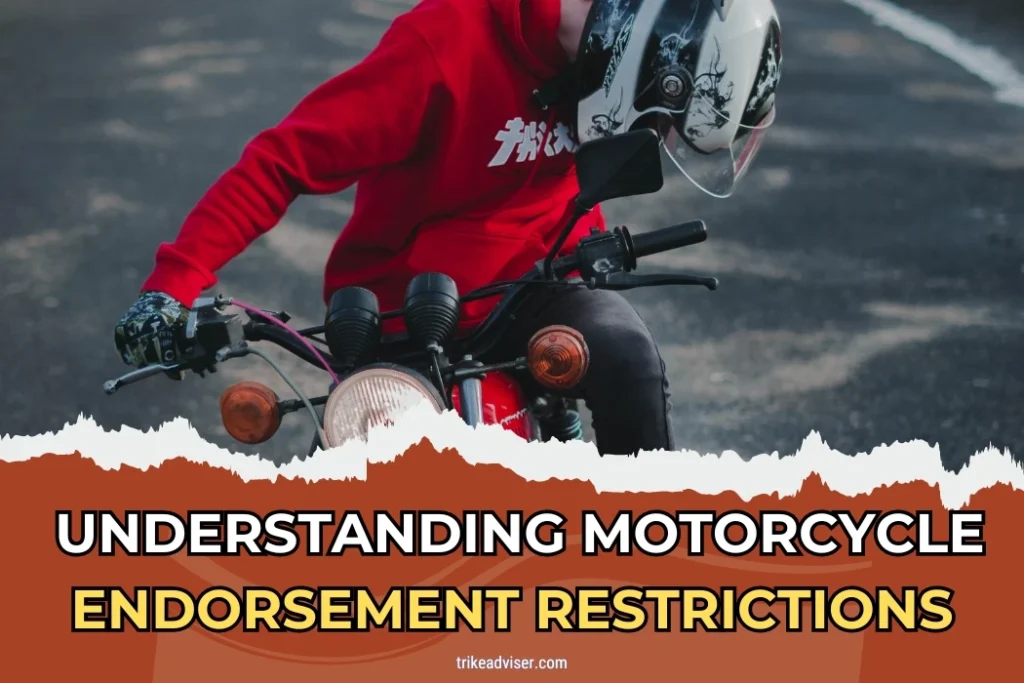Think getting your motorcycle endorsement is just about age? Think again. It’s not so simple. Each state throws its curveballs.
Age restrictions? Check. Training courses? Often mandatory. And the bikes themselves? They’re part of the equation too. Picture this: you’re 16, eager to hit the open road on a shiny new bike.
But your state says, “Not so fast.” Maybe they demand a training course first. Or limit the engine size you can handle. Frustrating, right? This isn’t just a teenage problem.
Even seasoned riders face hurdles. Moving states can reset the rules. What worked in Montana might not fly in Florida. Navigating these laws feels like decoding a complex puzzle.
Any Age, Any Bike? Understanding Motorcycle Endorsement Restrictions

Age Restrictions for Riding a Motorcycle
Navigating the age requirements across states can be like playing a geographical lottery. Consider this:
- In the heartland states like Arkansas, North Dakota, and South Dakota, young enthusiasts can start riding at 14.
- Jump over to New Mexico, and the bar lowers even further to 13.
- Contrast this with Hawaii, Arizona, and Missouri where teens can get their wheels spinning at 15 and a half, but they’re benched at night and can’t bring friends along for the ride.
- In the Northeast, states like Rhode Island, New Hampshire, and Pennsylvania play it safe, setting the minimum at 16.
Each state crafts its laws from a cocktail of factors: road safety stats, teen maturity assessments, and local advocacy inputs. Knowing these can help parents and young riders set realistic expectations.
How to Get Started
Ever think about how pilots need flight hours before they can fly solo? It’s somewhat similar for new motorcyclists.
- Most states insist on a period under the wing of an experienced rider, which can be a few weeks to several months.
- In Colorado, you need to navigate the roads with a standard driver’s license before you can tackle a motorcycle endorsement test.
- Down in Georgia, the gateway to riding any motorcycle is the class-M driver’s license.
Local motorcycle clubs often offer mentoring programs that not only help in meeting these requirements but also steep the new rider in a culture of safety and respect for the road.
M1 and M2 Endorsements
Here’s where it gets technical:
- M1 endorsement: This is your golden ticket, allowing you to ride motorcycles, mopeds, and scooters.
- M2 endorsement: More restrictive, limiting you to machines with engines no bigger than 150cc. Think of it as training wheels for the road.
These distinctions are not just bureaucratic red tape. They’re built on data linking engine power to accident rates among new riders. Choosing the right endorsement can be a key factor in a novice rider’s long-term safety.
Requirements for Obtaining a Motorcycle License
This journey varies dramatically from one state to another:
- Some states are lenient, allowing teens as young as 13 to ride with proper permits.
- Others have stricter requirements, requiring applicants to be at least 16 or even 18.
There is more to obtaining a motorbike license than merely attaining a particular age. It necessitates completing written and driving exams covering everything from emergency procedures to traffic legislation.
States often update these tests based on the latest road safety research, making frequent check-ins at your local DMV a must.
The Legal Landscape – Age and Motorcycle Endorsements

It takes skill to navigate the intricate web of laws that differ greatly from state to state when riding a motorcycle, in addition to the excitement of the ride. Now let’s unravel this terrain.
Age Requirements and Legal Restrictions by State
When you’re sixteen, you probably dreamed of owning your first motorcycle. That ideal may seem unattainable, but it could also be right around the corner, depending on where you live.
California: At 16, you’re eligible, but if you’re under 18, think of your learner’s permit as a six-month teaser before the real deal.
Connecticut: Also starts at 16. Here, though, there’s a catch: pass a motorcycle safety course, then get your endorsement like a badge of honor.
Delaware: Need a driver’s license first. It’s like a prerequisite course before the main event—passing the knowledge exam and applying for your motorcycle badge.
Florida: At 16, you’re in, but minors endure a 90-day test of patience with their permits.
Georgia: Patience until 17. Under 18? Add a compulsory safety course to your pre-riding checklist.
Hawaii: The gates open at 16, but those under 18 must hold their permits like a promise for 90 days.
Missouri: Younger start at 15 and 6 months, but the road to licensure is paved with mandatory safety courses, especially if you’re under 16.
Montana: Eligible at 16, or a year earlier with a course. Under 18? The safety course is your entry ticket.
Impact of These Laws on Motorcycle Accessibility for Different Age Groups
Young Riders (Under 18): Wrapped in layers of safety courses, permit periods, and adult supervision, the journey to motorcycle endorsement is both a protective bubble and a proving ground. It’s about nurturing a responsible attitude towards riding from a young age.
Adult Riders (18 and older): Once you hit 18, the training wheels come off, metaphorically. You’re considered capable of making informed decisions about your riding safety.
Why the Rigor?
Safety is paramount. Statistically, motorcyclists are at a higher risk of fatal accidents than car drivers. States craft their laws to prepare riders, not scare them away.
Think of it as compulsory education that saves lives. In 2019 alone, helmets saved an estimated 1,859 lives, and an additional 802 could have been saved if all motorcyclists had worn helmets. These laws aren’t just red tape; they’re lifelines.
Additional Restrictions and Considerations:
Helmet Laws: Mandatory for under 18s in many states, these laws are like seat belts for motorcyclists. In places like Connecticut, the penalty for flouting this can be as tangible as a $90 fine.
Moped Specifics: In Florida, for example, mopeds must fit very specific criteria related to engine size and speed capability, ensuring that these vehicles remain in the light-duty category.
Practical Tips:
Know Your State’s Laws: Before you even shop for a bike, understand your state’s specific requirements. This could save you from legal headaches and ensure you’re properly trained.
Plan for the Long Haul: If you’re under 18, view the extended permit periods and mandatory safety courses as opportunities to refine your skills in a controlled environment.
Adopt safety gear and defensive driving as part of your riding identity to live a safer lifestyle. Riding a motorcycle properly is equally as important as simply riding.
Although navigating motorcycle laws can be difficult, it’s all a part of learning how to become an experienced rider.
Like any journey, your experience will be better if you are better prepared. Put on your helmet, start your car, and drive safely and lawfully into the sunset.
The Role of Training in Motorcycle Licensing

Starting the path to motorcycle expertise requires a significant commitment to control and safety, in addition to being exciting.
Let’s examine why accredited training programs are not only advantageous but also essential, as well as how state-by-state variations in these standards may occur.
Importance of Certified Motorcycle Training Programs
Training for motorcycle riding isn’t merely a box to tick on your way to licensure—it’s about building a foundation so solid that the road feels like an extension of yourself.
Crucial Skill Development: The Motorcycle Safety Foundation’s Basic RiderCourse (BRC) isn’t just educational; it’s transformative.
Tailored for beginners aged 16 and up, it tackles the nitty-gritty—from the roar of the throttle to the precision of pinpoint braking.
Mental Preparedness: These courses teach you to think like a rider. Understanding the ins and outs of two-wheeled transportation, planning escape routes, and anticipating obstacles on the road are not only skills but survival tools.
Practical Experience: Over a weekend, two 5-hour on-bike sessions put you in the saddle, hands on the handlebars, learning through doing.
From basic maneuvers like U-turns and lane changes to emergency responses, every minute builds your confidence and competence.
Beyond the Basics: Completing the course could streamline your path to licensure, offering waivers for practical tests in many states—a testament to the course’s rigor and respect within the biking community.
Overview of How Training Requirements Vary Across States
There is no one-size-fits-all approach to motorcycle training; it varies as much as the states’ topographies.
The thorough approach used in Virginia may entail receiving a motorcycle endorsement through a combination of classroom instruction and real-world riding experience, making sure riders are ready for both the written and road exams.
Ohio’s Youth Focus: For Ohio’s young riders, the mandatory 16-hour Basic Rider Skills course is a rigorous blend of classroom instruction and on-cycle practice, specifically designed to instill young riders with the skills and confidence needed to navigate the roads safely.
Military Precision: For military personnel, such as those in the Navy, motorcycle training is about precision and discipline.
The requirement to progress through multiple levels of training ensures that riders are not just prepared for personal rides but are also up to the stringent demands of military readiness.
Expert Insights and Practical Tips:
Stay Updated: Motorcycle laws and training requirements can change. Regularly checking with your state’s Department of Motor Vehicles or local motorcycle training facilities ensures you remain compliant and informed.
Embrace Continuous Learning: Once you’ve mastered the basics, don’t stop there. Advanced courses can sharpen your skills and introduce you to high-level riding techniques that can dramatically improve your safety and enjoyment on the road.
Safety as a Habit: Treat safety gear and defensive riding not just as requirements, but as integral parts of your riding philosophy. The best riders are those who ride prepared, aware, and respectful of the road’s dangers.
Motorcycle training is the crucial first chapter in your riding story. Think of it as a mix of boot camp and meditation retreat: it rigorously tests your physical skills while fine-tuning your mental focus.
Every lesson learned is a potential accident avoided, and every skill mastered is a step towards becoming not just a rider, but a road-wise motorcyclist.
Impact of Restrictions on Teen Riders

Teen motorcycle riders experience both thrills and sobering realizations when navigating the road thanks to state-mandated regulations aimed at protecting these inexperienced riders as they develop their abilities.
Challenges Faced by Young Riders
Jumping onto a motorcycle as a teen might feel like freedom, but this freedom comes with its own set of challenges:
- Experience Gaps: Unlike their older counterparts, teen riders often lack critical real-world riding experience. This isn’t just about handling a bike; it’s about making split-second decisions that could avert disasters.
- Development of Critical Skills: Mastering a motorcycle requires precision—something that develops over time. Teens are still learning to sync their reflexes with the demands of the road, which increases their risk for accidents.
The road for teen riders is as much about learning as it is about enjoying the ride. Each ride is a lesson, every mile a new chapter in developing mastery.
Benefits of Restrictions in Promoting Safety
These restrictions might seem like a set of annoying roadblocks, but they’re strategic safeguards designed to protect young lives.
- Targeted Risk Reduction: Restrictions like no nighttime riding or passenger bans aren’t arbitrary. They’re based on data showing that these conditions significantly increase risks for inexperienced riders.
- Structured Skill Advancement: By limiting young riders to less complex traffic environments, we’re allowing them to build their skills gradually and solidly. Think of it as learning to swim in shallow waters before tackling the deep ocean.
- Promotion of Formal Training: Safety courses are more than just a prerequisite for licensing; they are crash courses in survival. They teach maneuvers that could save lives, fostering respect for both the bike and the ride.
The Crucial Role of Parental Involvement
Behind every skilled teen, rider is often a supportive parent, guiding them through the twists and turns of early motorcycle experiences.
- Enforcement of Rules: More than just setting boundaries, engaged parents enforce them, providing a consistent framework within which young riders can explore their capabilities safely.
- Mentorship and Monitoring: Supervised rides allow for real-time coaching and feedback, which is invaluable. Watching a teen handle a tricky curve or navigate busy streets can be a teachable moment.
Enhanced Insights for Safer Teen Riding:
- Embrace the Restrictions: View each restriction as a stepping stone to becoming a seasoned rider. Restrictions are not just rules but tools for building safe riding habits.
- Gear Up Every Time: The right gear can save your skin. Helmets, gloves, jackets, and boots—wear them all, every time, no exceptions.
- Progressive Riding Challenges: As skills improve, gradually introduce more challenging riding conditions—but always under supervision or with expert guidance. This approach ensures that when the restrictions lift, the rider is truly ready.
It takes perseverance, practice, and a lot of learning to go from a novice teenage rider to an experienced motorcycle.
It’s about appreciating the steps involved, appreciating the process, and realizing that each regulation serves as a foundation for future riding safety. Recall that the objective is to ride for years to come, safely and competently.
As an Amazon Associate, I earn from qualifying purchases, at no additional cost to you. Read Our Affiliate Disclosure.

